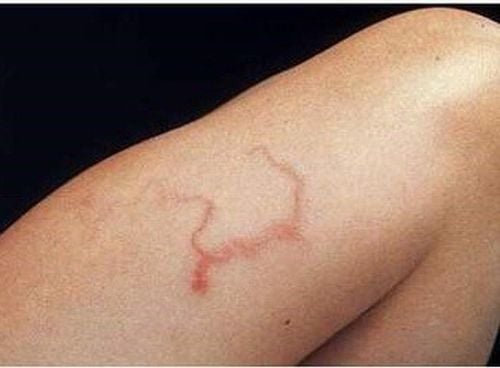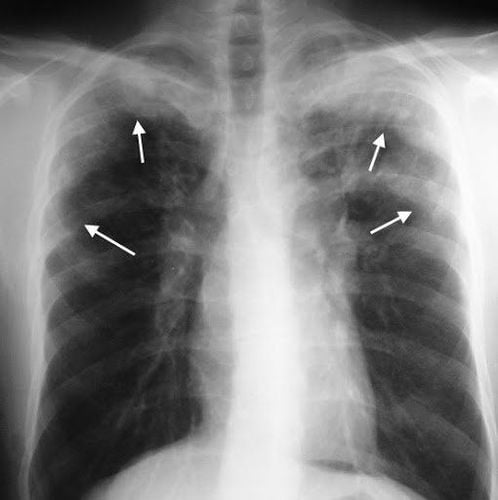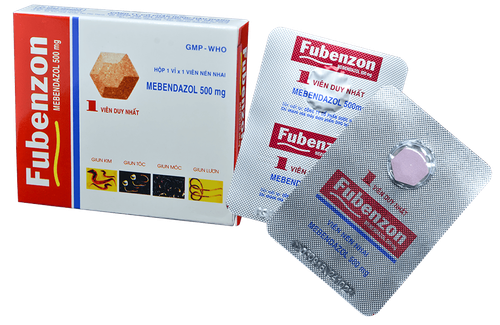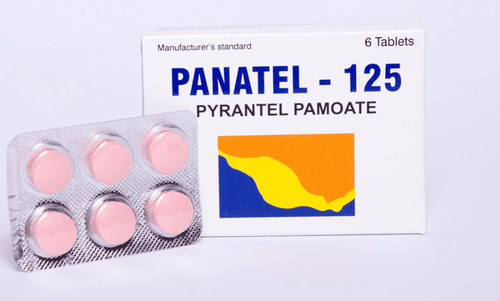This is an automatically translated article.
Pulmonary parasitic infection occurs as one of the pathogenic manifestations in the life cycle of parasites in the human body. The body will respond by increasing eosinophils in the lungs, which is characteristic of Loeffler syndrome. The etiology of Loeffler syndrome is related to various worm diseases, with modes of transmission and mechanisms of pathogenesis.
1. Roundworm infection
Ascariasis (Ascaris lumbricoides) is the most common cause of Loeffler syndrome. These worms are parasites that use the human body as a host to grow from larvae or eggs into adult worms. Adult worms that reach reproductive capacity can be more than 30 cm long.Ascariasis occurs most often in children in tropical and subtropical regions of the world - especially in areas with poor sanitation and environmental conditions. It is also one of the most common worm infections in people worldwide and goes unrecognized because most people infected are mild and asymptomatic. However, severe infection can lead to serious symptoms and complications depending on which part of the body is affected:
In the lungs: After swallowing the roundworm eggs, they hatch in the small intestine. and larvae migrate via the bloodstream or lymphatic system into the lungs. At this stage, people may experience signs and symptoms of Loeffler syndrome, which are similar to those of asthma or pneumonia, including persistent cough, shortness of breath, and wheezing. After 10 to 14 days in the lungs, the larvae migrate to the throat, where the person coughs up and usually swallows them back into the digestive tract. Intestinal: Larvae mature into adult worms in the small intestine and adult worms usually live in the intestine, laying eggs until death. Symptoms of intestinal roundworms are vague abdominal pain, nausea and vomiting, diarrhea or bloody stools. If a patient has a large number of intestinal worms, usually a child, there will be acute severe abdominal pain, severe vomiting due to intestinal obstruction, and the presence of worms in the patient's vomit or stool.

Bệnh giun đũa (Ascaris lumbricoides) là nguyên nhân thường gặp nhất gây ra hội chứng Loeffler
2. Hookworm infection
Hookworm infection (Necator americanus) is also an obligate parasitic roundworm that lives in the small intestine of a human host. The habitat of hookworms is in warm climates because to hatch the eggs need a moist, warm and shaded environment. Males are usually 7-9 mm long, while females are about 9-11 mm long. Their lifespan can be up to 3-5 years and they can produce between 5,000 and 10,000 eggs per day.
The life cycle of this worm begins with an unhatched egg in the soil. After 24-48 hours, the eggs become embryos and hatch into larvae, which molt several times into young worms and can penetrate human skin, travel through blood vessels and the heart, and then to the lungs. Here, it passes through the pulmonary alveoli and up the trachea, where it is swallowed into the gastrointestinal tract and carried to the small intestine. Worms attach to the intestinal wall, suck the blood of the host, grow into adults and begin to reproduce, laying eggs that are excreted in the feces.
During the process of entering the body, some larvae cannot easily pass through the dermis and remain trapped in the skin, causing skin irritation. When they reach the lungs, they cause symptoms such as a profuse cough and shortness of breath, wheezing, which is a manifestation of Loeffler syndrome. When reaching the intestines, the worms can cause a loss of 30 μl of blood per day, causing iron deficiency anemia in patients, fatigue in adults, and mental retardation and growth retardation in children. Moreover, patients infected with hookworms will often experience abdominal pain, which increases after meals, accompanied by diarrhea, abdominal distension and nausea.
3. Strongyloidiasis
Strongyloides stercoralis (Strongyloides stercoralis) is a disease caused by roundworms, classified as soil-borne helminths and causing disease in humans. This means that the primary mode of infection is through contact with soil contaminated with free-living larvae. When the larvae come into contact with the skin, they can penetrate the skin and travel throughout the body, eventually making their way to the small intestine, where they grow and lay eggs.Unlike other soil-borne worms such as hookworms, strongyloidiasis eggs hatch into larvae in the intestine and are excreted in the feces. Therefore, these newly released larvae will be able to immediately re-infect the host by entering the intestinal wall, or penetrating through the skin around the anus. It is this mechanism that makes it possible for a person to self-infected with strongyloides throughout life.
However, the majority of people infected with strongyloides are asymptomatic. If symptoms are present, patients often describe discomfort that is not specific or general. Some people experience abdominal pain, bloating, heartburn, diarrhea, and constipation. Some people develop a dry cough, shortness of breath, and wheeze and are diagnosed with Loeffler syndrome. Others have had skin rashes, arthritis, kidney and heart damage.

Phần lớn những người bị nhiễm giun lươn là không có triệu chứng
4. Roundworm infection of dogs and cats
Toxocariasis is a human disease caused by larvae of toxocariasis (Toxocara canis) and roundworms of cats (Toxocara cati). This is a disease that belongs to the group of visceral larvae. Depending on the site of infection, the degree of eosinophilia, and ocular or pulmonary findings, the terms for larval migration vary. In which, when worm larvae cause disease in the lungs, patients also have symptoms similar to worm infections such as roundworm, strongyloidiasis and hookworm mentioned above, diagnosed as Loeffler syndrome.
5. How to diagnose and treat worm infections
To diagnose diseases caused by worm infections, the doctor may review the symptoms and order some tests for parasites :
Blood tests: Worm infection will cause eosinophilia in the external blood. Because; Stool examination: There is evidence of eggs or larvae in stool; Imaging: A chest x-ray will show opacities that migrate over time, which are hyperpermeable lesions with eosinophils in Loeffler syndrome. Abdominal ultrasonography may show worms in the bile ducts, pancreatic ducts or cause lesions in the liver parenchyma. Treatment of filariasis is instituted when there is evidence of worm infestation in the body. Antiparasitic drugs are the first-line treatment against common worm infections in humans, most commonly albendazole, ivermectin, and mebendazole. These drugs, when taken for one to three days, kill the adult worms. Side effects from the drug include mild stomach upset or diarrhea.
However, it is still important to be proactive in prevention as well as to prevent re-infection. Everyone needs to build a sense of good hygiene, wash their hands with soap, eat well cooked food and drink, and build systematic housing. sanitary faeces treatment system, combined with educational campaigns on eliminating the use of outdated latrines, especially in rural areas. For children, parents need to guide children to wash their hands often with soap, do not put their hands in their mouth, quit the habit of biting nails and walking barefoot.

Chụp X-quang phổi sẽ thấy các đốm mờ di chuyển theo thời gian
In summary, besides the relatively rare drug-induced cause, Loeffler's syndrome is mainly caused by worm infections. Although the disease tends to be self-limiting, the symptoms are not severe, and if prevention instructions are not given, the patient is very susceptible to re-infection. Therefore, building a sense of good personal hygiene, washing hands frequently with soap, eating cooked food and drinking hot water, periodically deworming, and treating modern toilets are important foundations for preventing worm infections as well as worm infections. prevent Loeffler syndrome. Currently, Vinmec International General Hospital is one of the leading prestigious hospitals in the country, trusted by a large number of patients for medical examination and treatment. Not only the physical system, modern equipment: 6 ultrasound rooms, 4 DR X-ray rooms (1 full-axis machine, 1 light machine, 1 general machine and 1 mammography machine) , 2 DR portable X-ray machines, 2 multi-row CT scanner rooms (1 128 rows and 1 16 arrays), 2 Magnetic resonance imaging rooms (1 3 Tesla and 1 1.5 Tesla), 1 room for 2 levels of interventional angiography and 1 room to measure bone mineral density.... Vinmec is also the place to gather a team of experienced doctors and nurses who will greatly assist in diagnosis and detection. early signs of abnormality in the patient's body. In particular, with a space designed according to 5-star hotel standards, Vinmec ensures to bring the patient the most comfort, friendliness and peace of mind.
Please dial HOTLINE for more information or register for an appointment HERE. Download MyVinmec app to make appointments faster and to manage your bookings easily.
Reference sources: mayoclinic.org, emedicine.medscape.com, impehcm.org.vn












